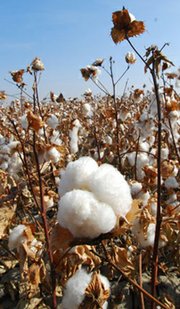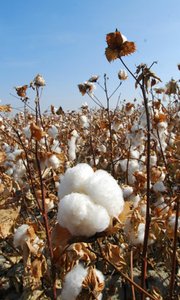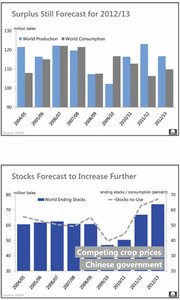Cotton Prices Drop, but Will Apparel Prices Follow?
Last year, apparel manufacturers were struggling with cotton prices, which had skyrocketed to an all-time high of $2.197 a pound in March.
China, the No. 1 cotton consumer, was buying up international cotton stocks, and India, the No. 2 cotton producer, was forbidding its cotton farmers from exporting.
To cut costs, clothing makers switched to cotton mixed with synthetic blends or made T-shirts that were a little thinner. Clothing factories raised their prices, and retailers did the same.
Now that December cotton futures are down to 67 cents a pound on ICE Futures U.S., everyone is asking whether clothing prices will drop, too, given that the cost of cotton is expected to remain steady for the next year.
“I don’t think any of the retailers are too anxious to bring down prices while enjoying the additional margin,” said Joe Wirht, a principal in Los Angeles apparel maker Topson Downs, which makes private-label goods for big-box retailers such as Wal-Mart, Target and JCPenney.
For now, everyone expects retailers to hold tight to the price gains they were able to carve out after years of declining apparel costs.
Those gains varied according to a store’s clientele. Between 2009 and 2011, mass merchandisers only raised their prices 0.4 percent, while department stores boosted clothing by 6 percent and specialty stores went for a hefty 16 percent jump.
“We haven’t seen prices being cut on the retail level,” said J. Berrye Worsham, president and chief executive of Cotton Inc., a research and marketing organization in North Carolina funded by U.S. cotton growers.
As an example, Worsham pointed out that in March the landed price of cotton goods arriving in the United States was down 7 percent from its peak in September. But in the last six months, the Consumer Price Index for apparel is up 2.6 percent on an annualized basis.
If the U.S. economy chugs along, store owners might be able to maintain those higher prices won last year. But if the economy weakens, consumers could be hungry for bargains.
“It all depends on how robust the consumers are feeling,” Worsham said. “Gas prices are going down, which is always good for apparel because it frees up discretionary income.”
Also, it takes retailers and manufacturers at least six months to one year to work through their inventory. Many stores are still selling goods that were made with the more expensive cotton.
That was noted by Scott Hurd, vice president and controller of American Eagle Outfitters, in a recent conference call with analysts. He said cotton pressures were down in the fourth quarter, but the teen retailer continues to sell through higher-cost products.
Also, retailers are dealing with added expenses, such as higher transportation costs due to high gas prices for much of the year.
In its first-quarter report, filed June 4, Macy’s noted that its cost of sales inched up because of free shipping to online customers.
Pressure cooker
Many manufacturers point out that today’s clothing prices are more realistic than in previous years. Between 2002 through early 2010, customers were paying less for apparel than they did in the early 1990s as manufacturers shifted their sourcing to countries where labor is cheaper.
“Maybe this is the balancing act,” said Lonnie Kane, president of Los Angeles womenswear manufacturer Karen Kane. “Maybe current prices are realistic.”
But pressures on retailers to bring down clothing prices could mount as the global economy is shaping up for a soft year.
England is already in a recession. Spain is dealing with a 24 percent unemployment rate and needs to prop up its precarious banking sector, which overextended loans during the hot real estate market a few years ago.
Elections in Greece on June 17 could determine whether that country steps up and accepts an austerity measure to help repay its government debt or exits the Euro zone. Even China is showing a decline in consumer spending.
Recently released official data for April showed a slowdown in China’s retail sales growth to 14.1 percent, the lowest in 14 months. Slower sales are a result of a prolonged credit crunch in the property sector and flagging demand from export markets.
The United States’ economy is also on a health watch. Unemployment inched up last month from 8.1 percent to 8.2 percent as the labor market only added 69,000 new jobs in May, the fewest in a 12-month period.
“From the conversations I have had with retailers, they, thus far, don’t feel resolved to drop their prices, but I think we have to put that into context,” said Liz Pierce, a retail analyst with Roth Capital Partners in Newport Beach, Calif. “Up until the Easter shift, we had a fairly strong season with good momentum that pulled sales forward, but there are a lot of unknowns right in front of us.”
She said there could be some price repositioning on basic items. But anything with a fashion value will be more resistant to downward movement. “The rule of thumb is if you bring something new to the table, you can charge an appropriate price and get a good margin,” Pierce explained.
No cotton crunch
The good news in all this cotton talk is there should be an abundant supply of the commodity over the next 12 months.
“Cotton prices have been pretty remarkably stable since we started the new calendar year in January,” said Jon Devine, senior economist at Cotton Inc.
In the United States, cotton production is expected to be up 10 percent to 17 million bales in the 2012/2013 season even though the cotton acreage being planted is down 10 percent.
The harvest increase is because last year Texas, the largest cotton producer in the United States, experienced a severe drought that stunted its cotton harvest.
Also, world cotton stocks are climbing after last year’s high cotton prices put a damper on cotton consumption.
At the conclusion of the 2011/2012 season, the U.S. Department of Agriculture estimates that a record 66.9 million bales will be carried forward as ending stocks. In 2012/2013, the USDA expects ending stocks to swell to 73.7 million bales.
Another piece of goods news is that India decided not to curtail its cotton exports again this year. Last year it attempted to limit its cotton harvest to domestic consumption so that its apparel factories could buy the commodity at a reduced price.
China also has a reserve program that helps keep cotton prices stable for its mills while guaranteeing a healthy supply for its garment factories. In 2011/2012, purchases by the Chinese reserve impacted the world cotton market and led to a record volume of Chinese imports of 21.5 million bales.
But Devine said the Chinese government won’t be as active this year in buying up cotton because Chinese mills aren’t expected to be as busy with the downturn in the European economy and a decline in U.S. apparel consumption.
For the year ending March 31, 2012, U.S. retailers imported 3.7 percent fewer garments and textiles from China than in the previous 12-month period even though the dollar value was up 4.6 percent. China accounted for 41 percent of all apparel brought into the United States.

























